How To Use Behavioral Activation (BA) To Overcome Depression
When we are depressed we become less active. The less active we are the fewer opportunities there are for positive and rewarding things to happen to us. And the fewer rewarding things that happen to us the lower our mood becomes. Behavioral Activation (BA) is one way out of this vicious cycle. It is a practical and evidence-based treatment for depression.
The relationship between what we do and how we feel
Psychologists have found that there is a close relationship between our activity and our mood. When we are feeling good we spend time with people whose company we enjoy, do activities that make us feel good, and take on new tasks and adventures that challenge us as individuals. All of this activity has positive feedback effects:
- Doing things we enjoy gives us feelings of pleasure
- Challenging ourselves means that we have a chance to grow and develop, and gives us a sense of mastery
- Having positive relationships with other people makes us feel connected and valued
The reverse is true too. People who are depressed tend to do less overall and so they have fewer opportunities to feel pleasure, mastery, and connection – the things we need to feel good [1, 2, 3]. It is easy to fall into a trap:
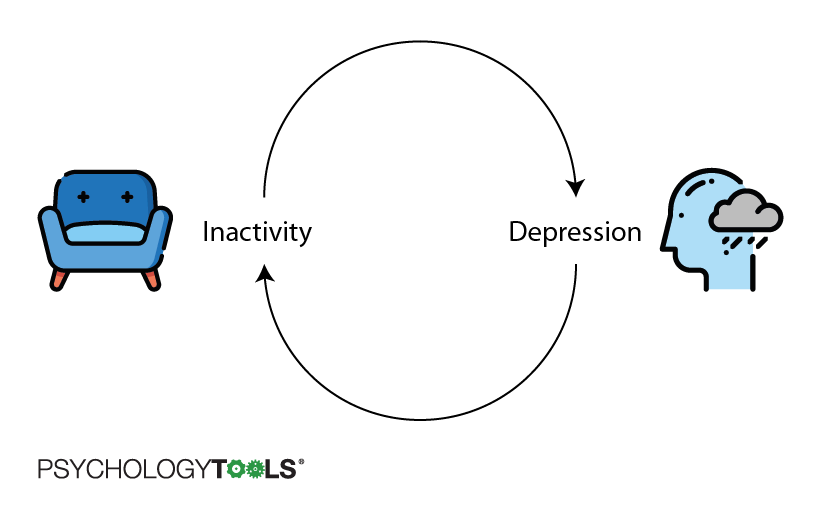
What is Behavioral Activation?
One way out of this trap is to wait until something external improves our mood – if it does then we might feel more like getting back to our old levels of activity. This approach is passive though, and it can leave you feeling helpless. One big problem with the passive approach is that you are likely to be waiting for a long time – left to themselves episodes of depression can last for months at a time!
A more proactive way of breaking the vicious cycle of depression is to increase our level of activity even if we don’t feel like it to begin with. This approach is called Behavioral Activation (BA) and it is a psychological treatment for depression with one of the biggest evidence bases to demonstrate how effective it is [4, 5, 6]. Behavioral activation for depression is about making your life meaningful and pleasurable again, it involves these steps:
- Learning about the vicious cycle of inactivity > depression > inactivity and understanding that we need to activate ourselves to feel better again
- Monitoring our daily activities to understand the relationships between our activity and our mood
- Identifying our values and goals (working out what really matters to us)
- Simple activation (scheduling and carrying out meaningful activities to boost our experiences of pleasure and mastery)
- Problem-solving any barriers to activation
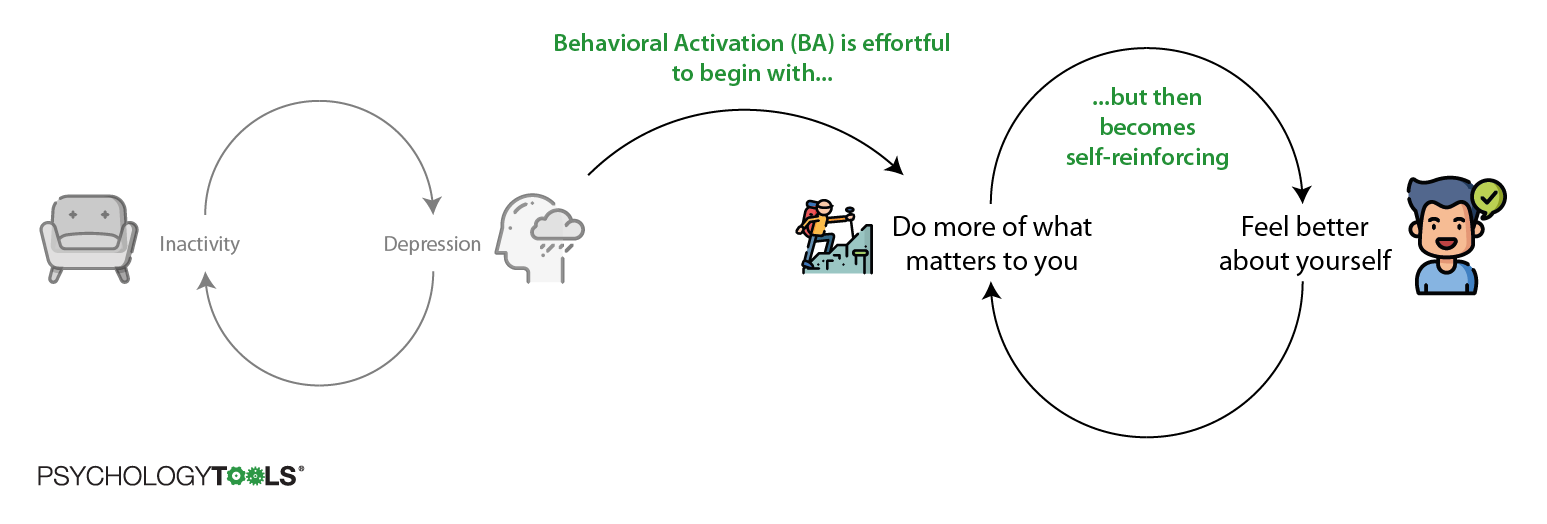
This guide will walk you through all of the essential steps to get you started with behavioral activation.
Activity monitoring: recording what you do and how you feel
The first step in behavioral activation therapy is to monitor your activity and mood to understand more about how your depression works. This is called Activity Monitoring.
You can use an activity monitoring worksheet to record what you do each waking hour every day for a week. Make sure to record everything on this behavioral activation worksheet – even activities that don’t seem very important. We need to find out how your mood changes as you do different activities, so rate your mood for each time slot on a scale of 0 to 10, with 0 representing feeling very depressed and 10 representing feeling very good.
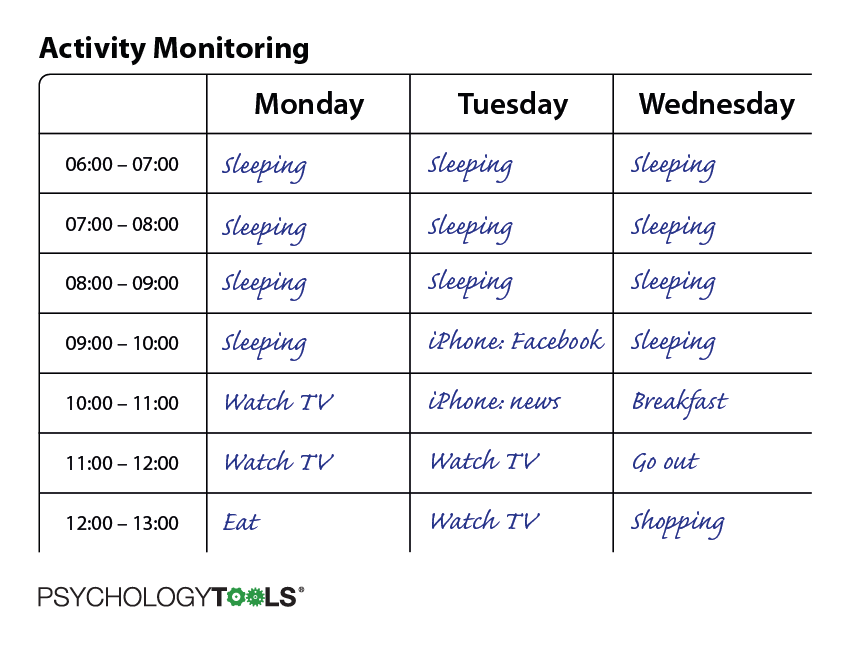
If you don’t have an activity monitoring worksheet an even simpler approach is to make a note of what you do for every hour of the day. You can do this on a bit of paper, or a note-taking app on your phone.
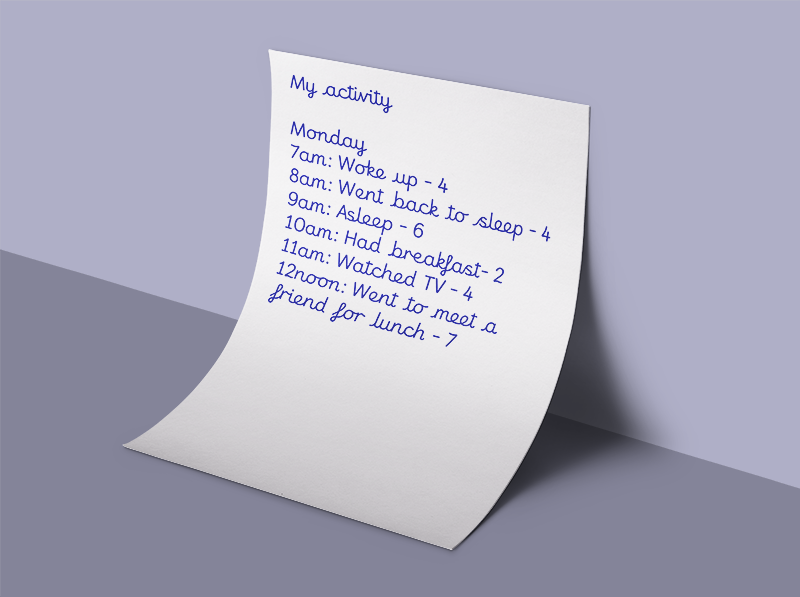
Reviewing your activity monitoring: learning about the association between activity and your mood
Once you have monitored your activity for a week you can use your activity monitoring record to look for patterns between your activity and your mood. Look at your completed behavioral activation worksheet and ask yourself these questions:
- What activities were associated with your highest mood? What were you doing when your mood was highest?
- What activities were associated with your lowest mood? What were you doing when your mood was lowest?
- What do you notice about the relationship between your mood and how active you were?
- Were there any days when you didn’t leave the house? What was your mood like on those days?
- What was your mood like on the days when you were most active?
Now make a list of activities which helped you to feel good, and which made you feel bad. You will use this list in one of the later steps.
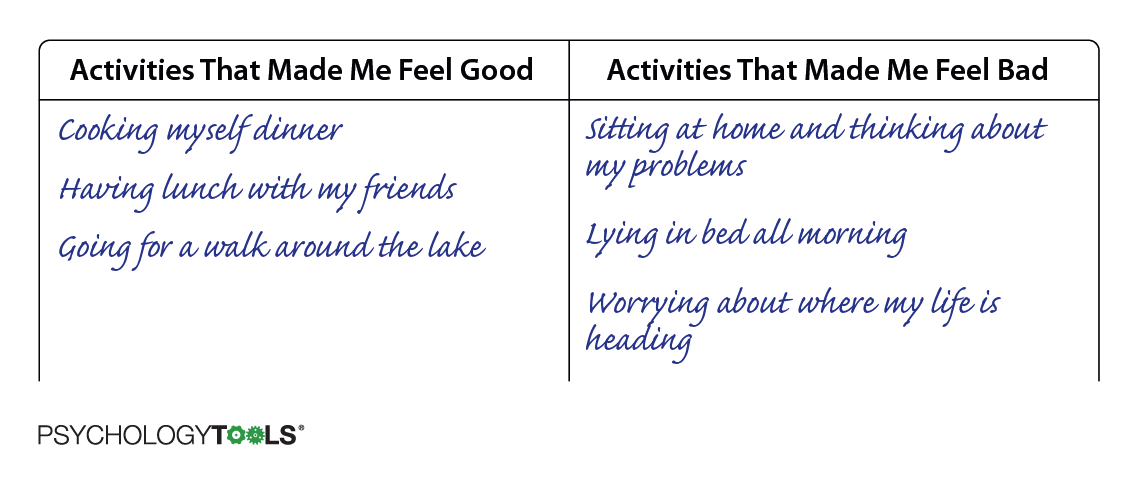
Values: thinking about what matters to you deep down
Our values reflect what we find meaningful in life. They are what you care about, deep down, and what you consider to be important. Everybody’s values are different, and they can change over time. They reflect how we want to engage with the world, with the people around us, and with ourselves. Psychologists think that a happy life is one where we are in touch with our values: where we are doing at least some of the things that we think are important.
Values are different from goals. Put crudely, goals can be achieved whereas values are more like directions that we want to head in. For example we might have the value of being a good parent which may require a lifetime’s effort, and the specific achievable goal of getting my children to school on time. Or we might have the goal of going for a jog while placing value upon our physical health.
The domains below are valued by some people. There might be values you think are important, and others that don’t matter so much to you. There are no ‘right’ answers. Read the descriptions and think about what makes for a meaningful life that you could value.
| Value | Description |
| Family | What kind of relationships do you want to have with your family? What sort of brother / sister / mother / father / aunt / uncle / niece / nephew do you want to be? How do you want to be in those relationships? |
| Marriage / couple / intimacy | What kind of husband / wife / partner do you want to be? What kind of relationship do you want to be a part of? What sort of partnership do you want to build? What kind of person do you want to be in a relationship? |
| Parenting | What sort of parent do you want to be? What qualities do you want your children to see in you? What kind of relationships do you want to build with them? |
| Friendships / social life | What sort of friend do you want to be? What friendships is it important to cultivate? How would you like to act towards your friends? What kind of social life matters to you? |
| Career / employment | What kind of work is valuable to you? What qualities do you want to bring as an employee? What kind of work relationships would you like to build? What kind of work matters to you? |
| Education / personal growth / development | How would you like to grow as a person? What kind of skills would you like to develop? What matters to you about education and learning? What would you like to know more about? |
| Recreation/ fun / leisure | How would you like to enjoy yourself? What relaxes you? When are you most playful? |
| Spirituality | What kind of relationship do you want with God / nature / the Earth? |
| Citizenship / environment / community | What kind of environment do you want to be a part of? How do you want to contribute to your community? What kind of citizen would you like to be? |
| Health / physical wellbeing | What kind of values do you have regarding your physical wellbeing? How important to you is your health? How do you want to look after yourself? |
Spend some time thinking about your values. Which values are important to you? How successfully you are living your life in accordance with your values at the moment? Use the table below to guide your thought process.
| Value | Description of your values | Importance How important is this value to you? (Rate 0-10) |
Success How successfully have you lived your life in accordance with this value in the past month? (Rate 0–10) |
| Family | |||
| Marriage / couple / intimacy | |||
| Parenting | |||
| Friendships / social life | |||
| Career / employment | |||
| Education / personal growth / development | |||
| Recreation/ fun / leisure | |||
| Spirituality | |||
| Citizenship / environment / community | |||
| Health / physical wellbeing |
Simple activation: planning and engaging in valued activity
The next step of behavioral activation is to get active. You know by now that it is important to increase your level of activity even if you don’t feel like it to begin with. With behavioral activation for depression we can kick-start your activity by planning it and sticking to the plan. Get a piece of paper and write down a selection of possible activities.
Good places to get some activation targets for your activity plan are:
- Get activation targets from your activity monitoring worksheet: Which activities were best at improving your mood?
- Get activation targets from your values assessment worksheet: Which values matter to you the most? What activities could you do that would be in line with your values? For example, if family is something you value perhaps you could plan to spend time with them doing something specific.
- Make sure that you are doing the basics: Be sure to include targets like washing and brushing your teeth every day, doing laundry every week, cooking meals, shopping for food, and to include some activities that are social and which mean you will have contact with other people.
- Use an activity menu: Use a list of activities that have helped other people to pick some that you think might lift your mood.
| Activities menu Do some exercise Meet a friend for coffee Cook a meal for someone Clean the house Take a bath Listen to music you like Do something nice for someone |
Once you have written down a selection of possible activities it is time to create an activity hierarchy. This will help you to choose the best activities to get started with. To create your activity hierarchy write a list of activities and rank them according to how difficult you think they will be to accomplish (0 = not at all difficult, 10 = very difficult).
| Activity | Anticipated difficulty (Rate 0-10) |
| Go to an exercise class once this week | 7 |
| Get out of bed by 8am every day | 6 |
| Go for a haircut | 5 |
| Repair the kitchen shelf | 4 |
Now it is time to schedule some activities for the next week. Start by choosing some activities with low difficulty ratings. Write down the activities that you will do on an activity monitoring record form. It is important to be specific about:
- What the activity is
- When you plan to do it
- Where you will do it
- Who you might do the activity with
| Activity (What?) | Details (When? Where? Who? | Outcome & Rate Mood (Rate mood 0-10) |
| Go to an exercise class | Tuesday 6pm | Completed (7) |
| Get out of bed… | …by 8am every day | 5 out of 7 days |
| Go for a haircut | Thursday lunchtime, barber near home | Completed (5) |
| Repair the kitchen shelf | Monday morning, at home | Completed (8) |
Once you have planned activities for a week in advance the next step is to put the plan into action. Good luck!
Tips for getting the most out of behavioral activation
- Don’t start too hard: Life is a marathon, not a sprint. The new level of activity has to be more than your ‘depression level’ but it also has to be realistically achievable.
- Break activities down into smaller steps: Let’s say you had identified a value of becoming independent, but were living with your parents and weren’t qualified to drive. Some helpful steps towards your value of living independently might be making an online application for a driving license, or doing some budgeting to work out how soon you might be able to move into your own place.
- Reward yourself: Make the effort to acknowledge when you have completed something, and don’t just rush on to the next target. Some people find it helpful to make a ‘check off’ activities that have completed as an acknowledgement that they have done it. Can you think of a way of treating yourself if you complete half of your planned activities? What would a fair reward be if you completed all of them?
- Remind yourself why you’re doing this: Thoughts like “I’ll do it when I feel better” are insidious and can creep back in. Remind yourself often that it’s important to get active even if you don’t feel like it and that behavioral activation is one of the most effective treatments for depression.
References
[1] American Psychiatric Association. (2013). Diagnostic and statistical manual of mental disorders (DSM-5®). American Psychiatric Pub.
[2] Elfrey, M. K., & Ziegelstein, R. C. (2009). The “inactivity trap”. General Hospital Psychiatry, 31(4), 303.
[3] Roshanaei-Moghaddam, B., Katon, W. J., & Russo, J. (2009). The longitudinal effects of depression on physical activity. General Hospital Psychiatry, 31(4), 306-315.
[4] Ekers, D., Webster, L., Van Straten, A., Cuijpers, P., Richards, D., & Gilbody, S. (2014). Behavioural activation for depression; an update of meta-analysis of effectiveness and sub group analysis. PloS one, 9(6), e100100.
[5] Kanter, J. W., Manos, R. C., Bowe, W. M., Baruch, D. E., Busch, A. M., & Rusch, L. C. (2010). What is behavioral activation?: A review of the empirical literature. Clinical Psychology Review, 30(6), 608-620.
[6] Dimidjian, S., Barrera Jr, M., Martell, C., Munoz, R. F., & Lewinsohn, P. M. (2011). The origins and current status of behavioral activation treatments for depression. Annual Review of Clinical Psychology, 7, 1-38.